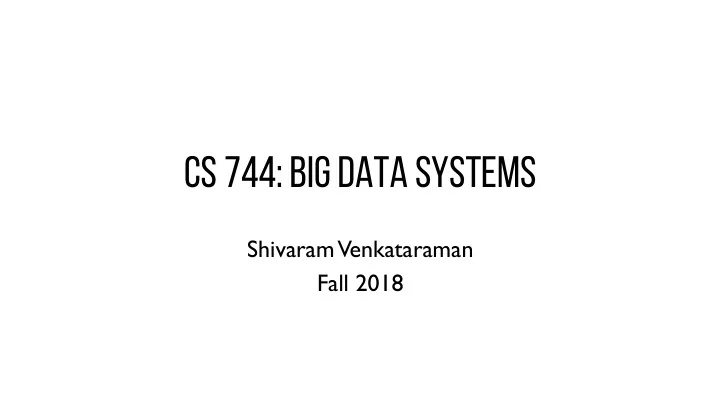

CS 744: Big Data Systems Shivaram Venkataraman Fall 2018
ADMINISTRIVIA - Midterm grades up today - Pick up papers office hours today or Tuesday class - Course Projects: round 2 meetings
Graph Mining
WHATS DIFFERENT ? Graph Analytics Graph Mining Examples Examples PageRank Counting motifs Shortest path Frequent sub-graph mining Connected components Finding cliques … …
GRAPH MINING: DEFINITIONS Graph G = (V, E) Vertices and edges have unique ids. Embedding sub-graph of G, i.e., subset of vertices and edges Vertex-induced – start from vertices, include all edges for vertices - - Edge-induced – start from edges, include all endpoint vertices Pattern any arbitrary graph Pattern is a template, embedding is an instance
AUTOMORPHISM, ISOMORPHISM Embedding is isomorphic to pattern iff one-to-one mapping between vertices, edges vertex mapped has same label edges connect matching vertices Embedding e is automorphic to e’ iff contain same edges and vertices
EXAMPLE: MOTIF COUNTING Motifs: Connected patterns that are non-isomorphic k=3 – two patterns k=4 – six patterns Goal: Find counts of each pattern in graph
FILTER PROCESS MODEL Two UDFs: Filter embedding Φ and Process embedding π Algorithm BSP Execution by Initial embedding set I parallelizing this loop For each embedding in set C <- generate embeddings(add one vertex) For each embedding e in C If Φ(e): F <- F U π(e) Terminate if F is empty else loop with I <- F
AGGREGATION FUNCTIONS Aggregation functions: Filter function α , Aggregate function β Similar to groupByWindowAndApply ? Consistency properties If embeddings are automorphic, all UDFs return same value Anti-monotonicity – filter return same values for extensions
OTHER APPROACHES Think like Vertex Think like Pattern - Vertex has local embedding - Don’t materialize embeddings - “Push” message to border vertex - Store patterns, recompute embeddings on the fly Cons - Highly connected vertex à hotspot Cons - Duplicate messages, one per border - Partition by pattern (fewer ?) - Popular pattern, load imbalance
ARABESQUE API: EXAMPLE boolean filter(Embedding e){ return (numVertices(e) <= MAX_SIZE); } Counting void process(Embedding e){ Motifs mapOutput (pattern(e),1); } Pair<Pattern,Integer> reduceOutput ( Pattern p, List<Integer> counts){ return Pair (p, sum(counts)); }
DISTRIBUTED EXECUTION Apache Giraph based distributed implementation Synchronous super-steps (BSP) - Workers receive messages sent previously [Embeddings] - Process messages [Filter Process] - Send new messages to be delivered [Aggregate output?] Can be implemented in any BSP system ? (e.g., Spark)
EXPLORATION STRATEGY Goals - Prune embeddings that are “identical” (i.e. automorphic) - Need to do this without coordination (why ?) Approach - Determine a “canonical” embedding (unique and extensible) - Canonical property - Start with smallest id - Add the neighbor with smallest id not visited yet - Incremental check while adding vertex to embedding
EFFICIENT STORAGE: ODAG Storage model: Ordered lists of vertex / edge ids (integers) ODAG format Store all first elements of embeddings in one array (and so on) Links between array indices if embedding has a such link Could lead to spurious embeddings
EFFICIENT STORAGE: ODAG ODAG benefits N vertices can have up to N k embeddings of size k ODAG upper bound O(k . N 2 ) (k << N) Using ODAGs Avoid spurious embeddings using filter, aggregateFilter Merging ODAGs Every worker creates ODAG outputs Use map-reduce to do the merge! Map each entry based on position to worker
OTHER OPTIMIZATIONS Partitioning Embeddings Performed at start of every iteration Round-robin scheme with block size b Estimate embeddings that start from a vertex Two-level aggregation Need to aggregate by pattern. Equality requires isomorphism check Quick pattern calculated locally and aggregated Use canonical pattern to do second level aggregation
SUMMARY Graph Mining: new workload that is compute and data intensive First system to do distributed graph mining Challenges: Lots of intermediate state (trillions of embeddings) Key ideas: Filter / prune embeddings using canonical definition Efficient storage using ODAGs
Recommend
More recommend